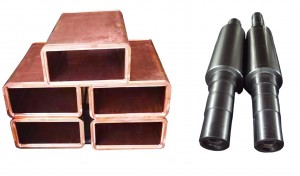Key Components in Metallurgical Processing: Copper Mould Tubes and Rolling Rolls

In modern steel production, turning molten steel into high-quality finished products depends on two critical components: copper mould tubes and rolling rolls. These parts play distinct but complementary roles—one shaping steel’s initial solidification, the other refining its final form. Understanding their functions, technical requirements, and failure modes is key to boosting industrial efficiency and product quality.
1. Copper Mould Tubes: The "Heart" of Continuous Casting
Copper mould tubes act as the inner lining of continuous casting machines, directly contacting molten steel. They are the primary medium for converting liquid steel (around 1500°C) into solid billets, making them indispensable to the casting stage.
Core Functions
- Forced cooling: Cooling water flows along the tubes’ inner walls, rapidly solidifying molten steel into a billet shell of a specific thickness. This prevents shape loss and ensures structural stability.
- Shaping and guiding: The tubes’ inner cavities are engineered into specific shapes (e.g., rectangular, circular) to define the billet’s cross-section. They also guide the solidified billet to move steadily downward, setting the stage for subsequent rolling.
Key Technical Requirements
- Material selection: Tubes must balance high thermal conductivity and wear resistance. Common options include phosphorus-deoxidized copper (TP2) and copper-silver alloys (Cu-Ag). For high-end scenarios needing better high-temperature strength, chromium-zirconium copper is used.
- Dimensional precision: Tolerances for inner cavity taper and wall thickness must stay within 0.1mm. Deviations can cause billet surface cracks or even "breakouts"—catastrophic molten steel leaks.
- Surface treatment: Inner walls are typically chrome-plated (Cr) or nitrided (N) to form a protective layer with hardness exceeding 1000HV. This extends service life, which usually ranges from 3,000 to 5,000 casting heats.
Common Failure Modes
- Wear: Relative movement between the billet and tube inner wall gradually wears the cavity. Regular inner diameter checks are needed to avoid dimensional errors.
- Thermal fatigue cracking: Repeated heating (from molten steel) and cooling (from water) creates thermal stress, leading to cracks on the tube’s outer wall—this is the top cause of scrapping.
- Steel adhesion: If the billet’s solid shell is incomplete, molten steel may seep into tube cracks and stick to the inner surface, disrupting casting.
2. Rolling Rolls: The "Force Executor" of Metal Forming
Rolling rolls are core parts of rolling mills that apply pressure to metal, causing plastic deformation. They transform cast billets or steel blooms into finished products (e.g., plates, pipes, profiles) and directly determine the final quality of steel.
Core Functions
- Pressure transmission: They transfer the mill’s rolling force to the billet, reducing its thickness, widening its width, or shaping it into specific cross-sections (e.g., I-beams, rebars).
- Plate shape control: Customized roll profiles (e.g., convex, concave) correct defects like warping or waviness, ensuring finished steel flatness.
- Surface quality control: Roll surface roughness directly impacts steel’s surface finish. For example, cold rolling rolls require mirror polishing to achieve a smooth steel surface.
Key Technical Requirements
- Material selection (by application):
- Cold rolling work rolls: High-speed steel (HSS) or semi-high-speed steel is preferred for its high hardness (85–90 HSD) and strong wear resistance—ideal for low-temperature, high-pressure cold rolling.
- Hot rolling backup rolls: Alloy cast steel or indefinite chilled ductile iron (ICDP) is used for its high toughness (impact resistance) and spalling resistance, handling hot rolling’s high temperatures and dynamic loads.
- Hardness-toughness balance: Higher hardness boosts wear resistance but reduces toughness. Manufacturers adjust material composition based on steel grade (e.g., carbon steel, stainless steel) to prevent roll breakage or spalling.
- Precision profile machining: CNC grinders create accurate roll profiles (e.g., CVC, PC profiles) with tolerances under 0.005mm, ensuring even pressure distribution during rolling.
Common Failure Modes
- Wear: Friction between steel and the roll surface causes gradual wear. Rolls must be periodically removed and ground (0.1–0.5mm per cycle) to restore their profile.
- Spalling: Inclusions or stress concentrations inside the roll can cause the surface layer to peel off in blocks—this severe failure halts production and requires costly replacement.
- Bending deformation: Excessive rolling force or uneven cooling bends the roll axis, leading to uneven steel thickness and poor plate shape.
Conclusion
Copper mould tubes and rolling rolls are irreplaceable in steel production, each overseeing a critical stage. Their performance directly affects efficiency, energy use, and product quality. By following strict technical standards for material selection, machining, and maintenance, manufacturers can minimize failures and keep metallurgical lines running smoothly.
Post time: Oct-16-2025